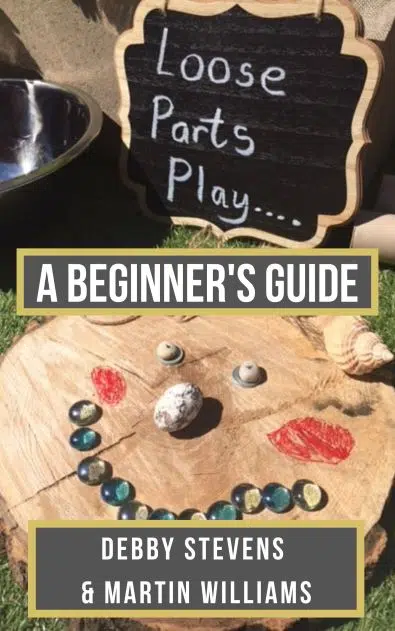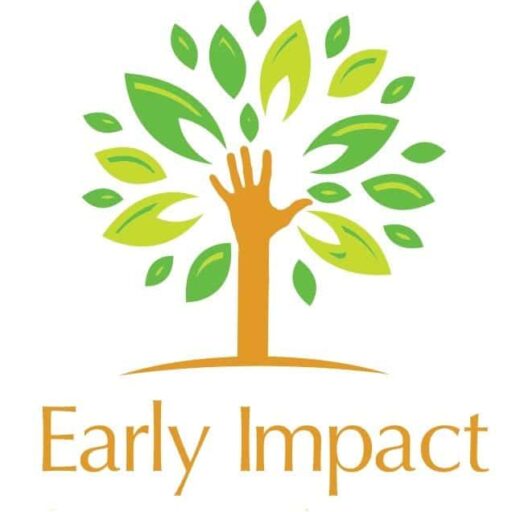Babies and toddlers can get involved in a wide range of loose parts play learning. One of the beauties of loose parts play is that children can access it more or less from birth.
Who is Loose Parts Play For?
When looking at loose parts play ideas on the internet and social media, there is often a huge proportion of provocations targeted at preschool-age children. Often I have been asked, can children under the age of two engage in loose parts play?
The simple answer is YES! As mentioned at the beginning, infants and toddlers can begin loose parts play learning starting from birth!
However, there is a definite process to go through. Loose parts learning will look very different based on the age of the child. This is something we really dig into on our online course ‘Project Loose Parts’ (that you can check out here). The overall concept of loose parts play is similar, but it will look different and you will require a slightly different approach for each of these age phases.
The rest of this article is equally applicable to either parents of children between the ages of 0 and 2, or of educators working within this age group, and the approach in either a setting or home is the same.
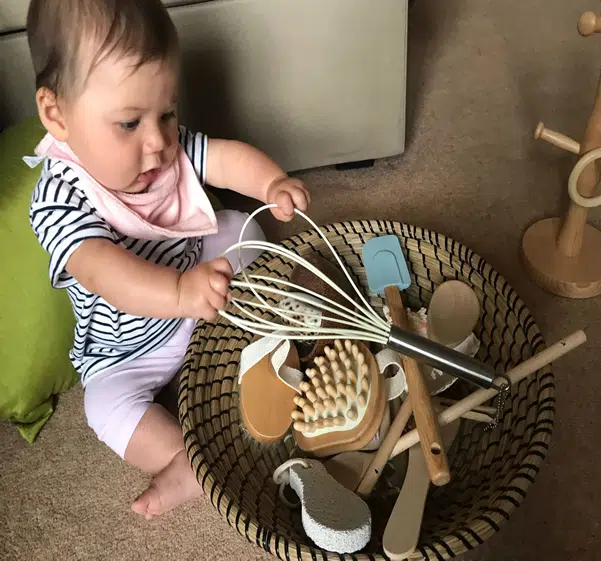
What Is Loose Parts Play?
In a nutshell, loose parts play is when children use objects that have no fixed purpose. Rather than playing with toys that have a clear intention, such as toy food in a pan, they are using objects that have no definite purpose. These objects encourage open-ended play or imaginative play.
For example, in play, a pine cone could be a magic seed, a tomato, a bird, a cow, or whatever the child wants it to be. It also doesn’t necessarily need to represent anything at all, and just be experimented with. The child might like to see how it rolls, or can stack it with other loose part objects, or hide it somewhere.
Loose parts play supports many skills in early childhood education including:
- Independence – It supports children in developing their own ideas, and having a sense of autonomy over their learning
- Imagination – Children develop ideas, narratives, stories and more
- Total engagement – They can often be found in a state of pure involvement which is a brilliant state of learning to be in
- They experiment with objects and the world around them
- They begin to make sense of the world
If you want to find out the full importance of loose parts pay for young children, then I have written an article all about the 14 crucial benefits.
Loose parts play is a fantastic form of open-ended learning.
But how, you may ask, can all this be adapted to suit babies and toddlers?
Introducing Loose Parts To Babies And Toddlers
Introducing Loose Parts at a young age gives children the confidence to access this form of learning with independence.
There is a definite age-related process to go through for different resources, learning opportunities, and ways of setting things up. Luckily, it starts pretty simple and gets increasingly more complicated as they get older.
Loose Parts Play for 0-5 Months
From birth, introduce lots of tummy time using a variety of textured materials, scarves and mirrors. Tummy time is important for the physical development of the body. This sows the seeds for developing the core muscles needed for fine motor skills and gross motor skills. It also begins the process of bodily development that will later result in body posture and even toilet training.
Provide lots of items to promote sensory play and develop hand-eye coordination:
- Scarves and ribbons
- Sensory balls
- Soft hand mitts
- Wooden curtain rings
- Homemade sensory bottles
- Textured materials
- Large mirror books
- Hair rollers
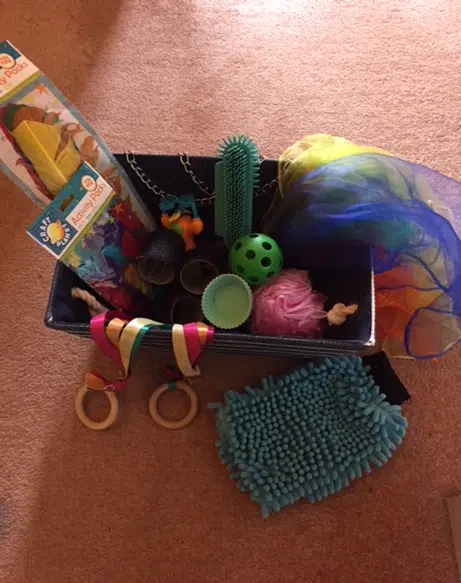
Babies are curious about everything in their surroundings, and you may well find that they are drawn to the strangest objects. Also, they may start to show that they have some favorite objects, even at this stage, and it is good for them to experience these open-ended play objects many times. This reinforces their prior learning and begins to link their past with the present.
Loose Parts Play for 6-12 Months – Treasure Baskets!
Treasure baskets are one of the best loose parts play ideas to get started on.
Once babies are sitting up (perhaps with support), introduce treasure baskets using lots of manmade and natural loose parts objects.
What Is A Treasure Basket?
A treasure basket is a container of a mixture of everyday objects, selected for their different properties and textures. To find out everything you need to know about treasure baskets, check out my article about what they are and how to use them.
Some top tips for a treasure basket include:
- Finding a good-quality wicker basket
- Ensure your basket is very shallow and round to enable babies to reach inside easily
- Fill it with a selection of safe objects. Beware of anything that they could get their fingers stuck in or items that are small and they may put in their mouths
- Select objects for their ‘heuristic’ properties. This basically means a selection of different sizes, textures, materials, and shapes.
Some great ideas for objects in your treasure basket could include:
- Wooden items
- Metal cooking utensils
- Natural objects
- Sensory materials
- Leather items
- A variety of measuring cups
- Large feathers
- Rubber tubes
- Brushes
- Seashell
- Wool pom-poms
- Keys
- Fleece
- Leather glove
- Nail brush
- Sponges
- Wooden spoons
- Fir cone
- Whisks
- Balls of different sizes
I have written the essential guide to all the ideas for objects for treasure baskets that you could ever need, and you can find that here.
It is amazing the length of play that you will sometimes observe when seeing babies engaged with treasure baskets. Some will be engrossed for thirty or forty minutes.
The role of the adult is more to observe as the child interacts with the objects. There is no need to get involved too heavily.
Don’t forget how important the key person approach is here to always be close to the babies for support and comfort. Also, remember to give them lots of time to discover these items at their own rate. Think of yourself as a facilitator rather than a teacher. You want to give them confidence in using objects for themselves which will really support them later when using loose parts to construct and de-construct.
Benefits of Treasure Baskets
Researchers have found many benefits from using treasure baskets, and it is one of the central resources to use with children of this age. You can find more of the huge number of benefits of this type of play in this article. Some excellent features include some of the following:
- Children develop concentration. Often babies can interact with a basket for an quite amazing length of time.
- They develop curiosity. This quality of curiosity is one of the central motivators for learning, as well as being important for living a happy and fulfilling life.
- They begin to make decisions for themselves. It is completely up to them which loose part object they select. It is also up to them what they do with it.
- A good activity to practice sitting. If children are thoroughly engaged in an activity with a treasure basket, they will develop their muscles and balance by sitting up for a prolonged time period.
- They learn to experiment and begin to make hypotheses about reality.
Some of these benefits, such as curiosity, really do underpin all learning. Curiosity is something that we promote in all of our online courses (that you can check out here).
Top Tips For Using Treasure Baskets
- Let them explore. Don’t interfere in the learning unless you need to.
- Think of yourself as a facilitator rather than a teacher.
- Use a shallow basket that is easy to access for the child, so they can take things out of it.
Loose Parts Play for 1 – 2 Years – Heuristic Play & Heuristic Baskets
By this age, babies will be exploring objects more and either making attempts to move or walk. This is when you can start to introduce Heuristic Baskets.
What Does Heuristic Play Mean?
Heuristic play is a term that was developed by the child psychologist Elinor Goldshmeid. It is connected to children’s natural curiosity about objects.
Infants and toddlers develop from being happy just to feel objects, to wondering what they can do with them. This is the process of cause and effect in action.
Children, particularly between the ages of 1 and 2, like to do the following things with objects:
- Fill them
- Dump them!
- Stack
- Handle
- Gather
- Manipulate
- Select
- Transport
- Roll
- Post
- Cover
The big difference between heuristic play at this age, and what has come before, is movement. The infants and toddlers will be moving, and the objects will be going with them.
Heuristic play is basically offering children a large number of objects to manipulate, and the space to do it without interference. There are many benefits to this type of play.
You will see a large amount of:
- Trial and error
- Repeating actions, particularly if they find something interesting
- Experimenting
- Curiosity about all objects
Heuristic Baskets
One way to get started with heuristic play is to create heuristic baskets. These are similar to treasure baskets, only the children will be manipulating the objects over a wide area, and you also want to think about things that will help them transport the objects, such as bags or boxes.
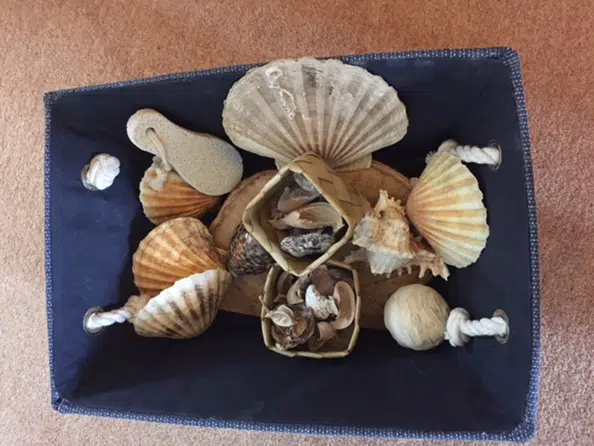
Some Top Tips For Setting Up Heuristic Play
- Provide lots of objects to transport: bags, boxes, different size containers and tubes.
- Baskets can be deeper than treasure baskets, as children are more able to get things out
- Use a mixture of natural and manmade objects
- Toddlers love to post, push, pull, roll, throw and experiment so ensure you have lots of items to support this type of learning (balls with scarves inside, a variety of soft hair rollers, silver kitchen items, bags, boxes, tubes, etc.)
- Toddlers learn through discovering, investigating, problem-solving, experimenting, trial and error
- Bring them out at certain times of the day and change objects in the containers to keep the interest going
- Ensure you have lots of heuristic items within your continuous provision areas
- Create a variety of themed boxes
- You may wish to include a few of the same items to avoid conflicts
- Keep in mind this is also a social activity that should promote sharing and social interaction.
Some of the things you can include in heuristic baskets include:
- Measuring spoons
- Egg boxes
- Cardboard tubes
- Greaseproof paper
- Rubber door stops
- Jar rings
- Corks
- Napkin rings
- Keys on a ring
- Whisks
- Teapots
- Colored ribbons
- Tea strainers
- Fruit, such as a lemon
I have created a resource of a list of at least 100 loose parts play materials that is definitely worth taking a look at.
Themed Baskets
Often, a basket can have some kind of central theme. This could be based on the materials, for example, having baskets that contain:
- Wood
- Metal
- Shells
- Plastic
Here, for example, is a silver heuristic basket:
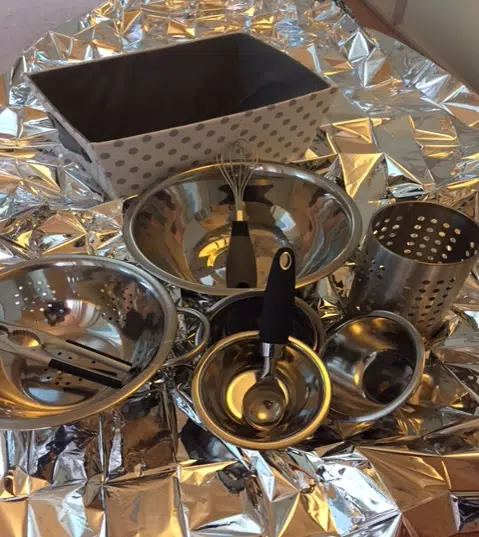
A bit of variation or rotation is good for infants and toddlers. You do not want them to get bored with the same objects available continually.
This is something to be aware of that is not so noticeable when they are younger. Treasure baskets require less rotation when the children are younger.
Also, rotating the loose part objects in the heuristic basket provides children with a range of different skills, textures, and visual features.
Benefits of Heuristic Play
It is probably no surprise to you that the benefits of heuristic play are quite similar to the benefits of using treasure baskets that I listed before. However, there are a few differences, so I thought I might as well list them for you here:
- It develops fine motor skills and gross motor skills. Children learn how to manipulate objects in multiple ways using their hands and other body parts.
- Creativity – There is a lot of imaginative play involved in exploring objects and seeing what you can do with them.
- There is an emphasis on experimentation. Infants and toddlers are like scientists inventing and re-inventing.
- Once again independence is crucial. This is a central skill in all forms of loose parts play.
- Decision making – Once again, children are deciding which object to use from a choice of several. They are then in total control of how to use them.
Loose Parts Play for Children Older than Two
Following this age, children will probably be able to take on a wider array of provocations, and loose parts play resources.
For a full guide of 40 excellent loose parts play ideas and activities to try out with this age group, why not check out this article – 40 Fantastic Loose Parts Play Ideas?
Loose parts play can be accessed through the preschool days, and into Reception (Kindergarten), and I believe even after this as well.
It is a great form of learning to promote literacy and maths for six and seven-year-olds. Many people think loose parts play should just be limited to the early years, but I personally do not think this is true. It is a power that can be harnessed much later on, even if it is just used as a ‘hook’ to get children engaged in an activity. One example I would use for this is getting a group of seven-year-olds to create a character’s face using a selection of loose parts, and then writing a description of what they have created.
Conclusion
Loose parts play is definitely accessible more or less from birth. It just looks a bit different based on the age of the child, and their level of development.
Luckily it starts easy, and gets more complicated later on – perfect to give you a chance at learning as you go if you are a parent, watching them get older.
It is also one of the cheapest forms of learning that exists. It really does cost next to nothing – all you need are a few random objects that encourage open-ended play, many of which you probably have lying around in your house anyway.
There can be definite magic in loose parts play when children get totally involved in what they are doing.
Good luck with the loose parts play with infants and toddlers!
Going to the Next Level, What is Next?
If you are passionate about creating an inspirational learning environment of loose parts, where learning can really thrive, then check out our online course ‘Project Loose Parts’. This is a two-hour video course that showcases more than 100 loose parts play ideas, and also the best sequence in which to start with loose parts to find success. You can find our Project Loose Parts online course page here.
This article is an extract from the book ‘Loose Parts Play – A Beginner’s Guide’ written by myself and my colleague Debby Stevens. This book provides a full, yet simple guide to setting up an outstanding loose parts culture in your home or educational setting with children aged 0-5. To check out the book on Amazon, then follow this link
